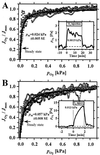High phosphorylation efficiency and depression of uncoupled respiration in mitochondria under hypoxia
- PMID: 11005877
- PMCID: PMC27151
- DOI: 10.1073/pnas.97.20.11080
High phosphorylation efficiency and depression of uncoupled respiration in mitochondria under hypoxia
Abstract
Mitochondria are confronted with low oxygen levels in the microenvironment within tissues; yet, isolated mitochondria are routinely studied under air-saturated conditions that are effectively hyperoxic, increase oxidative stress, and may impair mitochondrial function. Under hypoxia, on the other hand, respiration and ATP supply are restricted. Under these conditions of oxygen limitation, any compromise in the coupling of oxidative phosphorylation to oxygen consumption could accentuate ATP depletion, leading to metabolic failure. To address this issue, we have developed the approach of oxygen-injection microcalorimetry and ADP-injection respirometry for evaluating mitochondrial function at limiting oxygen supply. Whereas phosphorylation efficiency drops during ADP limitation at high oxygen levels, we show here that oxidative phosphorylation is more efficient at low oxygen than at air saturation, as indicated by higher ratios of ADP flux to total oxygen flux at identical submaximal rates of ATP synthesis. At low oxygen, the proton leak and uncoupled respiration are depressed, thus reducing maintenance energy expenditure. This indicates the importance of low intracellular oxygen levels in avoiding oxidative stress and protecting bioenergetic efficiency.
Figures




Similar articles
-
High resolution respirometry analysis of polyethylenimine-mediated mitochondrial energy crisis and cellular stress: Mitochondrial proton leak and inhibition of the electron transport system.Biochim Biophys Acta. 2013 Oct;1827(10):1213-25. doi: 10.1016/j.bbabio.2013.07.001. Epub 2013 Jul 11. Biochim Biophys Acta. 2013. PMID: 23850549
-
Mitochondrial inefficiencies and anoxic ATP hydrolysis capacities in diabetic rat heart.Am J Physiol Cell Physiol. 2014 Sep 15;307(6):C499-507. doi: 10.1152/ajpcell.00006.2014. Epub 2014 Jun 11. Am J Physiol Cell Physiol. 2014. PMID: 24920675
-
Mitochondrial respiratory control. Evidence against the regulation of respiration by extramitochondrial phosphorylation potentials or by [ATP]/[ADP] ratios.J Biol Chem. 1982 Mar 10;257(5):2397-402. J Biol Chem. 1982. PMID: 7061429
-
Bioenergetics at low oxygen: dependence of respiration and phosphorylation on oxygen and adenosine diphosphate supply.Respir Physiol. 2001 Nov 15;128(3):277-97. doi: 10.1016/s0034-5687(01)00307-3. Respir Physiol. 2001. PMID: 11718759 Review.
-
Regulation of energy metabolism in liver.J Bioenerg Biomembr. 1995 Dec;27(6):571-82. doi: 10.1007/BF02111655. J Bioenerg Biomembr. 1995. PMID: 8746844 Review.
Cited by
-
Methods for assessing mitochondrial function in diabetes.Diabetes. 2013 Apr;62(4):1041-53. doi: 10.2337/db12-1219. Diabetes. 2013. PMID: 23520284 Free PMC article. Review.
-
Mitochondrial function at extreme high altitude.J Physiol. 2016 Mar 1;594(5):1137-49. doi: 10.1113/JP270079. Epub 2015 Jun 26. J Physiol. 2016. PMID: 26033622 Free PMC article. Review.
-
Pathological Impact of the Interaction of NO and CO with Mitochondria in Critical Care Diseases.Front Med (Lausanne). 2017 Dec 22;4:223. doi: 10.3389/fmed.2017.00223. eCollection 2017. Front Med (Lausanne). 2017. PMID: 29312941 Free PMC article. Review.
-
Physical bioenergetics: Energy fluxes, budgets, and constraints in cells.Proc Natl Acad Sci U S A. 2021 Jun 29;118(26):e2026786118. doi: 10.1073/pnas.2026786118. Proc Natl Acad Sci U S A. 2021. PMID: 34140336 Free PMC article.
-
Biochemical dysfunction in heart mitochondria exposed to ischaemia and reperfusion.Biochem J. 2005 Sep 1;390(Pt 2):377-94. doi: 10.1042/BJ20042006. Biochem J. 2005. PMID: 16108756 Free PMC article. Review.
References
-
- Kasting J F. Science. 1993;259:920–926. - PubMed
-
- Martin W, Müller M. Nature (London) 1998;392:37–41. - PubMed
-
- Gray M W, Burger G, Lang B F. Science. 1999;283:1476–1481. - PubMed
-
- Hochachka P W, Lutz P L, Sick T, Rosenthal M, van den Thillart G, editors. Surviving Hypoxia: Mechanisms of Control and Adaptation. Boca Raton, FL: CRC; 1993.
Publication types
MeSH terms
Substances
LinkOut - more resources
Full Text Sources

